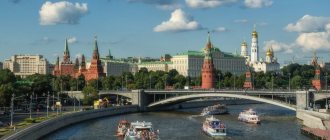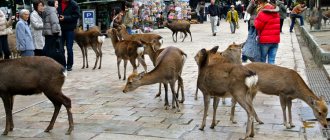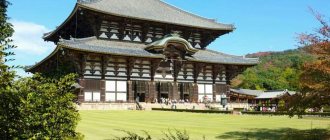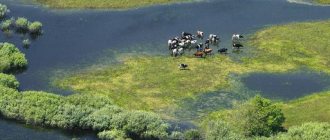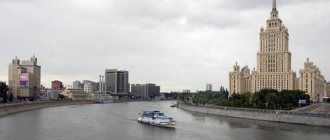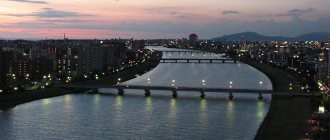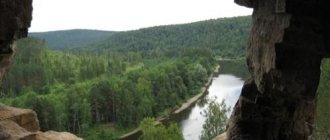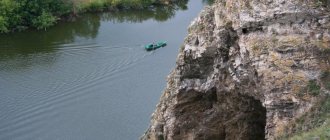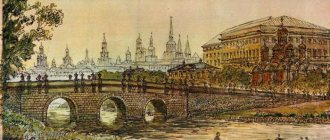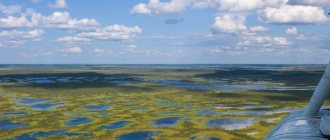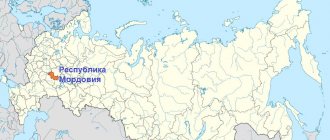Nara is a small town
By Japanese standards, Nara is a small city, because this city has “only” 400,000 inhabitants, almost the same as Tula. This city is located on the island of Honshu, in its southern part. Nara is also the capital of the prefecture of the same name (a Japanese province). The city may be small, but it is still one of Japan's most successful cities. Nara is full of schools, there are 16 colleges and 6 universities. However, Nara has more to offer than just school and study, tourists mainly go to Nara because of the many temples. In addition, the city is famous for Shinto shrines.
Japan's first permanent capital was established in 710 at Heiho, a city now known as Nara (奈良). Before this date, the capital was moved to a new location whenever a new emperor assumed the throne.
If you just don't feel like sightseeing, then tourists can completely relax in one of Nara's many parks, the weather is usually beautiful.
The Economist finds Tokyo is the safest city in the world
Horyu-ji
The religious complex is a 12-minute drive from the city. Like all the Seven Great Temples, it is filled with an atmosphere of oriental originality. Its main value is that almost all the buildings have reached us in their original form. Unlike its six brothers, the structure gives the impression of an airy and light structure.
Location: 1-1 Horyuji Sannai, Ikoma District.
A piece of Nara history
As the influence and political ambitions of the city's powerful Buddhist monasteries became a serious threat to the government, the capital was moved from Nara to Nagaoka in 784, and a few years later to Kyoto.
Empress Genmei founded the city of Nara around 600. Nara Prefecture had several major cities that acted as the capital of Japan, such as Asuka-kyu, Fujiwara-kyu (between 694–710), and Heiju-kyu (around 710–784). Around the same time, Nara took over the task of the capital of Japan, but the name Nara came later. The city had a rectangular street pattern (like New York) because the city map was based on a copy of the then capital of China.
The imperial palace stood at the northern tip, as in many Chinese cities. The city has many Buddhist monasteries that have hosted Buddhists for centuries. The western part of the city, however, was never fully built as planned. The city was too big and began to grow chaotically. The city's population grew and the city absorbed several villages.
Some parts of it were never completed, so you can find a completely abandoned amusement park called Nara Fairytale Land, which was never opened.
Nara the first capital of Japan
Nara is a small city of approximately 365 thousand people located in the Kansai region, but it is not just any city, but the first capital of Japan. Nara (the early name of Heijō-kyō), like many things in Japan in the first stages of the development of statehood, was built in the model and likeness of the Chinese capital of that time - Chang'an. The ancient civilization of China was of great importance in the formation of statehood, writing and religion in Japan.
The symbol of the first capital of Japan is the golden Buddha.
Nara, as the capital of Japan, was founded in 710, but the presence of a large number of Buddhist temples in the city and the enormous influence of Buddhist monks on the life of the city became a threat to the government and forced them to look for a new capital, which happened in 784. This year the capital of Japan was moved for a while to Nagaoko and then to Kyoto.
In general, the history of the capitals of Japan is quite a complex and confusing thing. Despite the fact that official sources indicate a certain period of time during which the city was the capital of the state, in fact the capital was repeatedly moved from place to place. So, even in the Nara era, the capital was moved to the city of Kuni-Kyou (now the city of Kamo) (740-744), in 745 the capital was the city of Naniwa-Kyou (now Osaka), then Nara became the capital again.
The development of Nara as the first capital of the Japanese state was an outstanding period in terms of the progress of Japanese architecture and art. This development took place thanks to extensive international exchanges with China and Korea, and at the same time the basis of politics and culture in Japan was already formed enough to have its own characteristic features. Many temples and shrines of that time can be seen today in Nara and feel the atmosphere of the ancient city, going back 1300 years.
It is believed that Nara, in its heyday, was a large city with a population of about 100,000 people. Here was the residence of the forty-fifth emperor of Japan - Shchomu (Semu), this is the first emperor of Japan to marry a commoner. Nara was also an administrative and political center with a large number of officials. It was in Nara that the mythical first emperor of Japan, Jimmu, descended from heaven riding on a deer. Therefore, deer in Japan and especially in Nara are considered sacred animals designed to protect the country and the city.
After the capital was moved from Nara, the development of the city stopped for some time, and during the period of internecine wars that occurred so often and for a long time in Japan, many architectural monuments of Nara were destroyed, since most of the structures were built of wood. The lands of Nara began to be used for agricultural land and the once majestic city fell into decay, however, centuries later, influential temples opposed this and Nara again became the capital of temples and shrines in Japan.
But not everything was so simple - many architectural monuments had to be restored from scratch, for example, to restore the “Sujakumon Gate” (Suzakumon is the red phoenix gate, this is the main gate of the Nara Temple), there was not even reliable information about what they looked like and the reconstruction of the gate was carried out on the basis a model built as a result of excavations, analysis and comparison of the distances between the columns and those fragments that could be discovered. Today we are greeted by a majestic 25-meter-high gate, reconstructed in 1998, built of cypress and concrete. When reconstructing the architectural monument, the seismological situation in the region was taken into account and technologies were used that would allow the gate to stand for another 500 years.
Also, based on the results of the excavations, the gardens were reconstructed, which restored the ancient image of the area. And in Nara, for more than 1,000 years, near the sacred Mount Kasugayama, deforestation was prohibited, and today these forests are considered pristine (primordial), in which Japanese cedars still grow, which are home to many rare living creatures. The forests themselves are a natural monument and it is surprising that these ancient forests grow next to the city. The forest is also a place for tourist excursions and can be visited for free every day. The forests contain 598 species of flowers, 175 species of trees, 1,180 species of insects and 60 species of birds and animals.
Nara is a favorite tourist destination for the Japanese; excursions to Nara are especially popular for graduating groups of kindergartens and graduating classes of schools. For foreign tourists in Nara, excursion tours are also organized, but as a rule, they are designed for one day. If you are planning an excursion for a longer period of time, you need to take care of booking a hotel (as in principle it is always advisable to do) in advance, since the city does not have a large number of hotels. Nara is one of the best places to admire the cherry blossoms in spring and the beauty of momiji leaves in autumn.
Sights of Nara - the first capital of Japan, which are recommended for tourists to visit;
- The central monument of the city of Nara is the imperial palace
- the ancient Buddhist temple of Todaiji is the largest wooden building in the world, it houses a huge bronze statue of Buddha
- and six more Buddhist temples
- the great Kasuga-taisha shrine is a Shinto shrine located near Mount Kasugoyama, surrounded by ancient forests
- Nara National Museum
- Nara Park, where you can feed tame deer
- Wakakusa Mountain will host its annual grass burning festival on January 25th.
Hot spots in Nara
Nara is less than an hour's drive from Kyoto and Osaka. Because of its past as the first permanent capital, the city is still full of historical treasures, including some of Japan's oldest and largest temples.
Kitakyushu City in Kyushu, Japan
The real hot spots of the city are the 5 large Buddhist temples that you cannot ignore while in the city. In addition, the city is famous for Shinto shrines (they are everywhere on the island of Honshu). At some shrines you will find the sacred Nara deer, large and small deer that roam freely among tourists.
Nara Park
Nara Park (奈良公園, Nara Kōen) is a large park in the center of Nara. Founded in 1880, it is home to many of Nara's major attractions, including Todaiji, Kasuga Taisha, Kofukuji and Nara National Museum.
Among foreign visitors, one of Nara's most popular attractions is the herd of free-roaming deer in Nara Park. These 1,200 or so deer, classified as a natural treasure, are a popular topic of social media posts that can be found under the tag #鹿活. The park has long protected deer in honor of the myth that the god of Kashima Shrine in Ibaraki Prefecture rode a white deer to Kasuga Shrine in 768.
Friendly deer will happily take the special crackers from your hand, but keep in mind that they are wild and easily feel threatened. Typically they take what they can get and move on, but recently several deer have become aggressive, even biting the hands that fed them.
Deer in the temples of the city of Nara.
Visit the imperial palace, which has beautiful Japanese gardens. Since the city is relatively small, you can plan to visit several attractions in one day.
Take care of your pants! A Japanese city defends itself from bears with the help of monsters
Horyuji Temple
Horyuji Temple (法隆寺, Hōryūji) was founded in 607 by Prince Shotoku, who is credited with early propagation of Buddhism in Japan. Horyuji is one of the country's oldest temples and contains the world's oldest surviving wooden structures. It was recognized as a World Heritage Site in 1993.
Attractions
Nara has a large number of old temples that attract tourists and pilgrims from Japan and all over the world. It is believed that the first mythical emperor of Japan, Jimmu, descended from heaven and arrived in Nara riding a deer. The sacred deer in Nara are seen as the descendants of that deer. Nowadays there are deer walking around temples and in parks, which are fed by tourists, and food for them is sold everywhere.
- Buddhist temples of Akishino-dera (Japanese: 秋篠寺)
- Todai-ji (Japanese: 東大寺) and pavilions Nigatsu-do, Sangatsu-do - kegon-shu school
- Kofuku-ji (Japanese: 興福寺) - Hosso-shu school, also represents the Kusha-shu school
- Yakushi-ji (Japanese: 薬師寺) - Hosso-shu school
- Toshodai-ji (Japanese: 唐招提寺) - Risshu school
- Gango-ji (Japanese: 元興寺) - subordinate to Todai-ji of the Kegon-shu school, previously belonged to the Sanron-shu, Hosso-shu and Kusha-shu schools
- Saidai-ji (Japanese: 西大寺) - Shingon-shu school
- Kasuga-taisha (Japanese: 春日大社)
- Nara National Museum
Along with Kyoto (capital of Japan from 794 to 1868), Nara is a favorite city for elementary and junior high school graduation trips. The historical monuments of Nara are included in the UNESCO World Heritage List.
Climate in Nara
The weather in Nara is similar to other areas of Honshu. In winter it is cool, the temperature is about 0-10 degrees. Summer is much hotter, with temperatures around 30 degrees. At night it gets cooler, about 20-25 degrees. If you are looking for a city with good weather in the summer, Nara is highly recommended.
Views: 1,980
Share link:
- Tweet
- Share posts on Tumblr
- Telegram
- More
- by email
- Seal
Liked this:
Like
Isuyen Garden
The traditional Japanese style garden is located in Nara Park. It occupies an area of more than 13 thousand m2, on which several picturesque reservoirs are located among lush greenery.
On two islands in the central pond there are figures of a turtle and a crane, which are considered symbols of Japanese longevity. The garden paths lead to wonderful tea houses. Since 1969, the Museum of Ceramics has been operating on its territory, the collection of which includes more than 2 thousand exhibits.
Description
The length of Nara is 158 kilometers. The river basin covers an area of 2030 km2. The width varies between 2-30 meters. The depth does not exceed 1.5 meters. There are collapsed and active dams along the river belt. In December, river waters are frozen, which break up in April. The famous Nara ponds are located in the upper reaches of the river. They feed the reservoir that connects them to the Oka.
The picturesque Nara River is shallow. However, it has a navigable section of two kilometers. The ships ply in the place where Nara connects with Oka. The Serpukhov port is also located here. From here tourists go on one-day cruises in two directions. The ships go to the Tula region, to Polenovo. In addition, they run along the coasts of the Kaluga region to Tarusa.
In spring, the not too wide and shallow Nara turns into a turbulent river. Its waters bubble capaciously and rush with great speed. During this period, tourists kayak along it. In the lower and middle reaches the banks are high and hilly. Most of them are covered with forests. In some places, the river flows through shady alleys formed by the crowns of mighty trees. In the area of the village of Chichkovo, small islands rise among the water surface, reaching a width of 30 meters.
Rainbow Waterfall
On Nara, a waterfall with the romantic name “Rainbow” roars loudly. It is located 45 kilometers from Moscow, near the village of Papino. In clear weather, the rays of the sun, refracting in the droplets, create a stunning spectacle: a bright rainbow above the cascading water jets. The lands between the Podolsk and Zhukovsky regions are replete with springs and springs, merging into a mighty stream flowing from a high peak.
At the bend of the Nara, next to the Oka, there is a stunning view of cascading springs and a waterfall. With the beginning of spring, when streams and rivers are filled with melt water, the waterfall on the Nara River turns into a fabulous natural object. It is extremely difficult to get to Raduzhny at this time.
There are no beaten paths leading to it. The surface of the winding dirt road becomes very muddy from the spring waters, becoming a continuous mess, insurmountable for vehicles. Summer and autumn rains wash out the country road to such an extent that it becomes a real test for cars.
The best time to visit the waterfall is dry summer days. Although the waterfall becomes shallow during this period and loses some strength, it leaves an indelible impression. The jets, falling from a five-meter height, rumble loudly and sparkle with a multi-colored rainbow, bewitching the eye and soul. You can take amazing photos at the waterfall.
